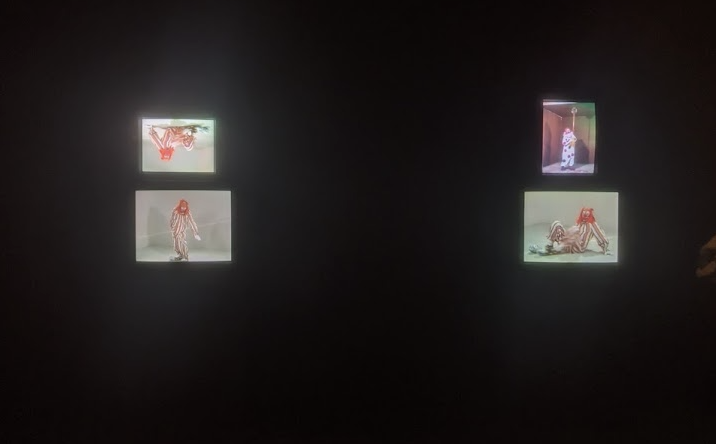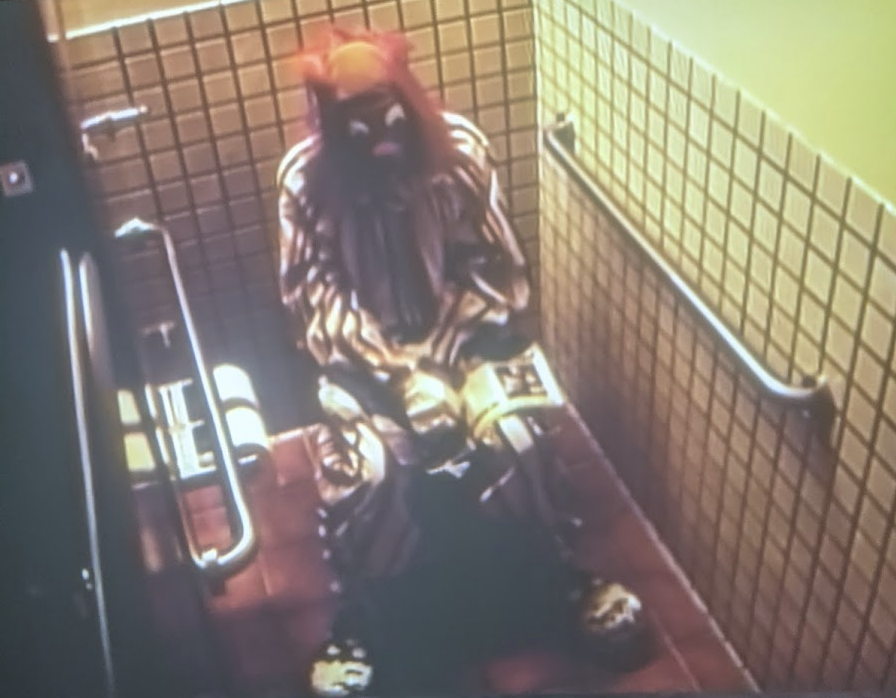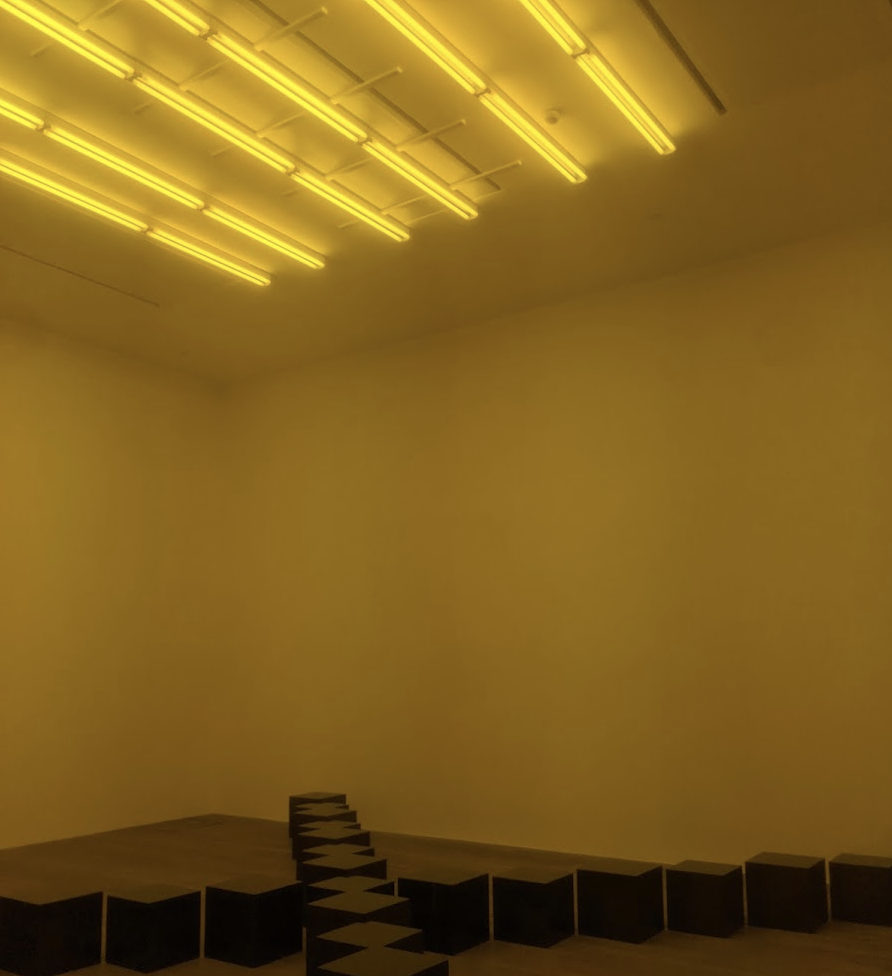Reflecting on Work so far & Planning for Project Proposal.
What Worked and What didn’t?
I would like to start with noting a couple of artists who I haven’t yet, but who also become a large part of my inspiration towards the final realisation and understanding of what I am trying to create. These artists are Ed Atkins and Tony Oursler.
Tony Oursler
After realising my focus on faces and facial expression I found one of Tony Ourslers exhibitions, The Dark Side, very inspiring towards the development of my work.
The art pieces seen below are particularly intriguing to me and my research as they have a round shape which is a repetitive theme in my work. So far I have projected into a tunnel like shape, I have masked a video into an ellipse shape, but have not tried to use a round object as a canvas.
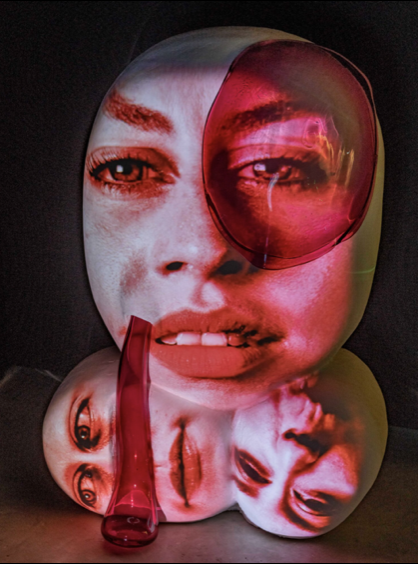
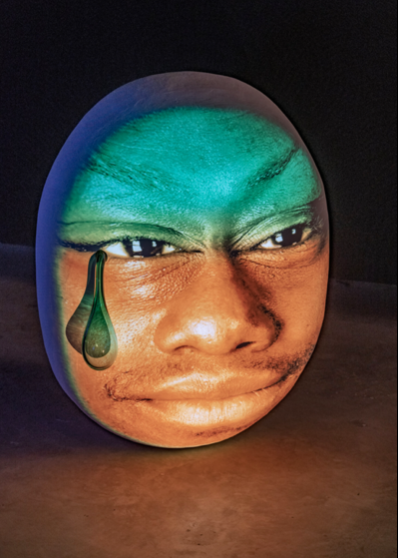
The distortion of the faces created through the choice of shape adds another layer of surrealism/distorted perception. I hope that enforcing this within my work ( the surreal and distorted perception) will help me reach my aim of simulating an experience of a state of panic.
Another thing I focused on was the lack of hair, ears and neck, (<follow link embedded here for an article by Lise Pennington which also bring up the lack of certain facial properties in Ourslers work) which are generally parts people associate with a face, but Oursler has decided not to include these parts. It does create a eerie sense and also makes me question if this could be a way of detaching the physicality of the face itself and focusing on the facial expressions it might create and the way it communicates emotion.
This theme I am mostly intrigued in of detachment of body and focus on facial expression and emotion also carries on into the work of the next artist I am about to mention.
Ed Atkins
Ed Atkins actually came up in one of the lectures in the initial weeks however at that time I did not look further into his work asI did not find the relevance of it when thinking about the state of panic as I do now.
Ed Atkins is a British contemporary artist who creates poetry through animation. His character often has monologues which make his thought audible for the viewer. The themes often explore
”loss, insufficiency, inability, failure and in particular melancholy plays a great role”
The protagonists whose visual qualities are so close to real life and so hyperreal that he emits this sense of uneasiness and artifice, even emptiness and detachment of mind from body. (refer to interview below, in regards to project “Something Is Missing”)
This is, as already mentioned in some way, something I want to achieve in my work in exploring the state of panic. Even though mind and body are a whole, when in a state of panic, one might experience a sense of dissociation and lack of realism and physicality. Despite portraying this state of panic through the physicality of a face and its features, I am eager to communicate the thoughts, emotions and surrealist environment through that. The mental through the bodily.
In representing this detachment from body, my hopes were to bring the attention to emotion and cognitive experience. I thought that even though I do not have the technical ability to create a hyperreal animation, animation itself has a quality which would allow me to distant the viewer from reality.
I initially used a 3D model I had made in sculptris. As seen in this video the head is deformed and at the time I wanted to make a more accurate head model so I moved onto cinema 4D.
I started by creating a face only instead. The intention behind making an incomplete head was to focus on facial expressions and not on the reality of what the viewer is looking at being a head. However this experiment quickly turned to different interpretations due to connotations of masks to tribes. I even got some feedback about a texture used for one of the masks giving it futuristic qualities, cyber robot like.
Both the idea of a mask and the choice of texture was not contributing towards communicating a state of panic.
Defining what exactly am I trying to achieve through this project:
In order to realise this project, I started by picking apart the concept of panic and thinking about the separate themes existing within it. The 3 reoccurring themes were perception, emotion and cognitive distortion.
After establishing these overlapping themes within Panic, I could conclude that in this project I am aiming to simulate or even provoke certain thoughts and emotions which one might experience in a state of panic. Or even the least create some sort of visuals which would make the viewer feel uneasy about it.
In order to do that I will be using a character which will be very up close and personal, meaning that the visual would essentially be a portrait of their face, which would allow the viewer to not only clearly see facial expressions which the character would be acting out but also even be able to relate to the character on some level or be empathetic to them. On top of this focus of facial expressions I will also be visualising how a space might be perceived in a state where the mind of a protagonist is not clear.
Cognitive Distortion
What is cognition and cognitive distortion and how the theory fits into my research?
Cognition is the mental processes involved in gaining knowledge and comprehension. (Including thinking, knowing, remembering, judging, and problem-solving.)
“Our ability to reason through logic is a prime example of cognition” – this quote is from a website which was the initial point of me understanding cognition and realising of its potential application within my research. I then went onto a more thorough research of the Cognitive Model of Panic as introduced by the British psychologist David Clark.
He explains how in cases where one’s cognition is distorted, they might not be able to reason through logic and might not be able to interpret thoughts or even sensations appropriately.
Cognitive distortion is described as an exaggerated or irrational thought pattern and Clark expand onto explaining how it closely relates to my theme of Panic.
In his cognitive theory of panic disorder, Clark suggests that panic states occur when sensations are misinterpreted (as indicating of an immediately impending physical or mental catastrophe. ) One feels loss of control and being out of control.
This lack of control mentioned is why I keep on coming back to the idea of a tunnel and the use of an ellipse shape. The confined space in a tunnel resonates lack of control whilst Annie Dillard’s Total Eclipse text reinstates this idea of being attacked and helpless.
That is why I think understanding and interpreting cognitive distortion is an essential part of being able to visually simulate a state of panic.
From understanding the state of Panic as a part of the human cognition, I went onto thinking about how that can be applied through camera. The first thing that came to mind was focal length. I read an article on a blog by McGregor (2016) called “How Focal Length Alters the psychological Impact of Your Image”. He briefly mentions how a fish eye lens is used in the movie City of Lost Children which has a talking brain in a fish tank as a character and they communicate its perspective as it sees the world through a fish eye lens. The world it sees through this fish eye lens becomes rather distorted and even scary which contributes to the concept of the movie which is that the children are kidnapped by a scientist in a surrealist society and he steals their dreams, hoping that they slow his aging process, which could be considered a rather dark and negative concept.
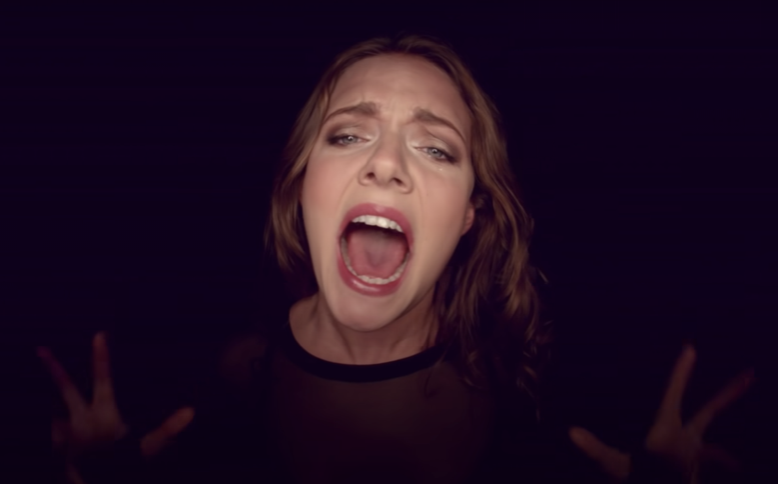
From there I also though about other instances where I had noticed a fish eye lens being used for the representation of a distorted reality or set of mind of character. One was a music video from 2014 of the song Habits by Tove Lo where the director had made a choice to use a fish eye lens to communicate a state of mind under the influence of alcohol/drugs.
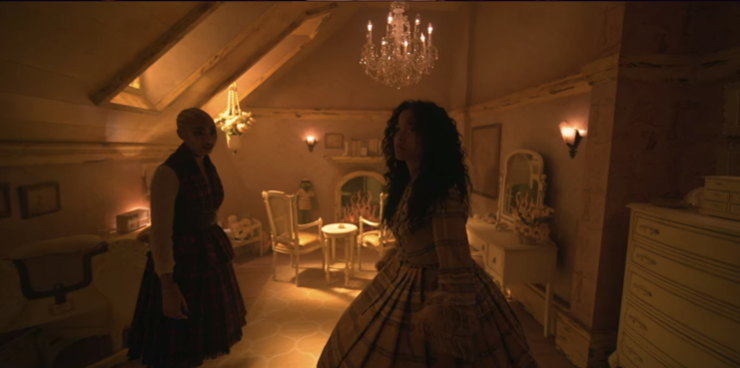
Another famous scene for its use of the fish-eye lens in distorting reality or even rather showing a reality from a distorted cognition perspective was Part 3 Episode 2 of The Chilling Adventures of Sabrina. In this episode two of the character are not of stable state of mind and so to protect them and themselves, the witches create a safe place but also a prison for them in a doll house, the doll house is shown through a fish eye lens in representation of the alternate reality and distorted state of mind.
Plan For Development
The plan for development is essentially to change my medium from animation to film and create a short video which will explore the state of panic through facial expressions and sound in relation to cognitive distortion and the theory of panic disorder. Here are the main aspects in bullet points to take in consideration:
- Hyperrealism through high frame rate
- Communicating thoughts through monologue type audio
- Fish Eye Lens – Cognitive Distortion
- Distortion through Installation inspired by Tony Oursler
More on Sound
As already mentioned, I started considering the audio aspect of this project because of the monologue type audio Ed Atkins uses for this characters which lets them communicate their thoughts and emotions in a clear and straightforward way. I believe that such a monologue would contribute to the context of the video massively.
I also however thought about Sound Effects and certain techniques and theories that might be applied through sound in communicating a distorted cognition and the panicked state of mind of the character.
Tom Garner
is a Senior Lecturer in Immersive Technologies at the University of Portsmouth within the School of Creative Technologies. His area of research is extended VR and he seeks to understand how humans behave in a real-world experience by looking at their behaviour in a simulation such as VR.
In my project proposal I mentioned the word simulation a few times and what I though of it in relation to my project is that i am not looking to recreate or replicate the experience of a panic attack but rather simulate it, create a sort of simulacra.
Tom Garner’s research has led me to imagine what soundscapes would be most appropriate to simulate this human experience of a panic attack through an immersive digital experience.
In the chapter Understanding Fear and Game Sound, from Game Sound from Behind the Sofa: An Exploration into the Fear Potential of Sound & Psychophysiological Approaches to Audio- centric, Adaptive Gameplay, he talks about how “reverberation is one regularly implemented effect that can affect a players perception of the game environment”
He goes on to explaining how reverberation and also delay are used to communicate architectural and material information of the environment.
“Long reverberations and delays suggest reflective spaces that are large in comparison to the listener who can be made to feel quite small and lonely through this technique”
(Garner, T.A., 2013. p. 50)
The text also mentions frequency manipulation or equalisation (EQ) to be a factor affecting the sound’s emotionality and aesthetic. These same tendencies of sound which can be used to communicate perception of environment, but also emotionality and aesthetic, can be applied further into cognitive impairment representation, such as the way it has been done in the Inpatient. A game about a character suffering from amnesia.
A short walk through of the “best moments” of the Inpatient can be seen below. The certain techniques of using echo, delay and reverb are introduced right from the beginning of the game.
Another research and artist who explored altered states of mind through sound is
Jon Weinel
He is a London based artist, writer, and researcher whose main expertise is in electronic music and computer art. His PhD research focuses on the use of altered states of consciousness as a basis for composing electroacoustic music.
As I’ve already mentioned a certain state of mind such as one of a person suffering from amnesia can be communicated through the use of these audio aspects of reverb, echo, delay and etc , however these spatial tendencies of sound can also be used to communicate other cognitive impairments such as cause by alcohol or drugs, as seen in the game Grand Theft Auto. In a chapter by Jon Weinel called Virtual Unreality it is discussed how sound design is altered to the state of mind of the protagonist. Sounds are processed with pitch transformations, echoes and reverberation suggesting the dissociative effects of alcohol and drugs as the protagonist becomes “distances from reality”. (refer to video below)
The two researchers and artist mentioned have informed me about sound and how the architectural properties of it such as reverb and echo can be used in a psychological and abstract way where the state of mind of a character is communicated as impaired or altered. The combination of audio as internal monologue and the above mentioned sound properties used to communicate an unstable state of mind will allow me to create a good balance where thought are communicated clearly for a strong contextual reference, yet abstract sounds strongly associated with impaired cognition such as the one a person would experience in a state of panic will allow for the simulation experience mentioned earlier.
For more information on Jon Weinel and his work, please visit his website at jonweinel.com
Script & Location
I knew that the script would be rather short as the mind of the character is distorted and they won’t even be able to communicate much, however even a few words can communicate the state of panic clearly.
Please refer to the script to be downloaded below:
Furthermore I will be using certain sound design techniques to communicate this distorted reality. I have familiarised myself of such techniques through texts written by scholars such as Tom Garner & Jonathan Weinel as previously mentioned in my Plan for Development.
The shot list was originally supposed to be a close up of face and facial expressions, but I spontaneously decided that on top of that projection of a face onto a round shape/sculpture, I would also like to create a short video which would be displayed on a flat screen. I think that the second piece might contribute to the context and add another layer of information on an educational level about mental health too. The second piece would be a scenario of the character walking down a very brightly lit tunnel/ art piece at King’s Cross designed by Allies & Morrison Architects, Speirs + Major, and light artists The Light Lab.
However I did originally look at some studios to shoot indoors as the initial idea was to literary just film a face and so my first priority of location was good lighting. Here is a list of my research into studios:
Robbie’s Photography Studio (1) – £30 ph
I’ve shot there before, so I am familiar with it and equipment provided. Robbie also offers assistance with lighting.
Studios I found on Tag Venue – £30 ph
Found this website online, unfortunately these studios are smaller and not as much equipment is offered in the price. It seems like the only offer backdrop.
Studios I found on Gumtree – £30 ph
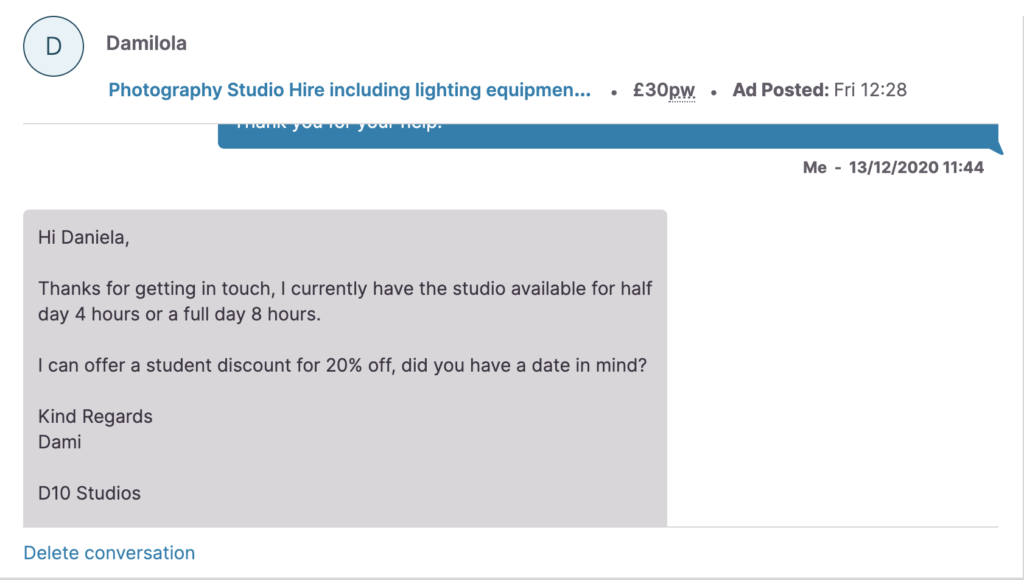
Damilola’s Photography Studio (5) (ALSO OFFERS STUDENT DISCOUNT)* I have emailed them for further information on that and waiting for reply.
They came back to me with an offer of 20% Student Discount which is quite good, but after considering what I could afford i decided to look at more budget studios.
Budget Studios: (£99 per day)
I found these on a different website called Photo-StudioHire
After coming across the Kings Cross Light Tunnel on my way to work I new it was the right location for my project, considering the idea has developed into 2 parts. The choice was to do my initial interest in confined spaces/tunnels but also because of the abstractions and intimidation the bright light adds when shooting in a high frame rate. The light of the tunnel becomes an attack on the character through this aggressive flickers which are created in error of the frame rate of the digital camera not matching the light source frequencies.
More information about the tunnel can be found here.
2 Seconds of Nothingness Inspiration
Inspired by 2 seconds of nothingness scene from euphoria.
Article reflecting on scene – Author. What is it About?
This piece is written by Jill Gutowitz who is a freelance journalist and writer. She has her own column called “Shut Up, Brain” on the lifestyle magazine, Nylon. Her writing covers a variety of topics but the important part for me is that she presents her findings through the lens of someone who lives with anxiety.
In this particular articles, she speaks about the way that anxiety is represented in the series Euphoria and the script itself in the particular scene 2 seconds of nothingness. Gutowitz says that Euphoria illustrates anxiety in a way that she had never seen before on TV, especially for young women. She relates to the character and her life experiences. Even though the experiences themselves are not the same, the way that Rue ( the main character) goes through life picks ups on certain aspects of anxiety that other representations in the media haven’t.
Bill Viola
“I realized one day that the object of the shot was moving, but when you slowed it down, emotions kept it going.”
Bill Viola, 2015
Bill Viola is a contemporary video artist. His work often explores the fundamentals of life such as birth, death but also states of consciousness.
In Ascension we see an actor falling into a body of water and our perspective as viewers is from underwater only. The fact that the speed is in slow motion creates a sense of disembodiment: the physical body of the person is descending and then ascending within the body of water, however the soul and the intangible somehow becomes omnipresent and more intense than the physical through this slow motion within the environment that we as viewers are observing.
I am suddenly not at all drawn to the physicality of the human physical body but am more concerned with the emotions of the character, and with the emotions of the viewer. This lack of realism in the speed of the turning of events is unsettling and allows almost too much information to be processed. Drawn to the way that the bubbles expand from the impact that the human body has created for the body of water but also anxious about the length of which the body seems to have not moved, the person is not fighting or swimming but is simply floating and very slowly ascending and the anxiety is provoked in anticipating the finale of this dream like drowning scene.
I have previously discussed hyperrealism and filming in a very high frame rate and how that could contribute in communicating emotion in ones facial expressions in order to communicating the state of Panic. My original intention was to film in very high frame rate and leave the footage at a normal speed to create a very uncomfortable and delusional imagery. However after carrying out some test shots and also examining some of Bill Violas works I have realised that using high frame rate and slowing it down can actually achieve the hyperrealistic qualities I am looking to employ in my work and question realism without creating simply not nice to look at robotic imagery.
Bruce Nauman (exhibition)

Studies for Holograms (a-e) 1970
In these screen prints on paper Nauman has used his face and skin as a material to manipulate like one would for instance do with clay. There are also some references to “making faces” in the way that a child might do. I suppose he is mimicking this child action but exploring it from a different point of view, possibly looking at the limitations of the human face or its strengths. The extreme close up of these prints create an uneasy feeling, almost as if one is in a disrespectful distance of the subject, in their personal space.
I was originally drawn to this piece because in my current project I am exploring the human experience of panic with strong visual references to face and its expressions. These prints made me think about the level of facial expressions I would like incorporated into my project, which is probably not on such an exaggerated level as Nauman has portrayed. I believe his piece includes this exaggeration mainly because of the reference to children ‘making faces’ as this is a rather immature and playful act and so it would not be anticipated in work exploring the state of Panic.
Clown Torture (1987)
Clown Torture is another piece of Nauman’s where he explores a contrasting aspect of children’s perspective, the one of clowns being entertaining. He however the negative sides of this archetype.
He was particularly interested in the clown’s obligation to perform and the way they have to mask their true self.
What intrigued me about this work was also the choice of installation. He had multiple videos which were looped and spread out within a room and this sort of arrangement allowed me to explore each and every video in it’s own space but also simultaneously with others and I immediately gained an understanding of what is being explored. What this understanding was for me is that what’s on the outside, even if it’s a character associated with constantly being overly cheerful such as a clown, is not a reflection of the inner self.
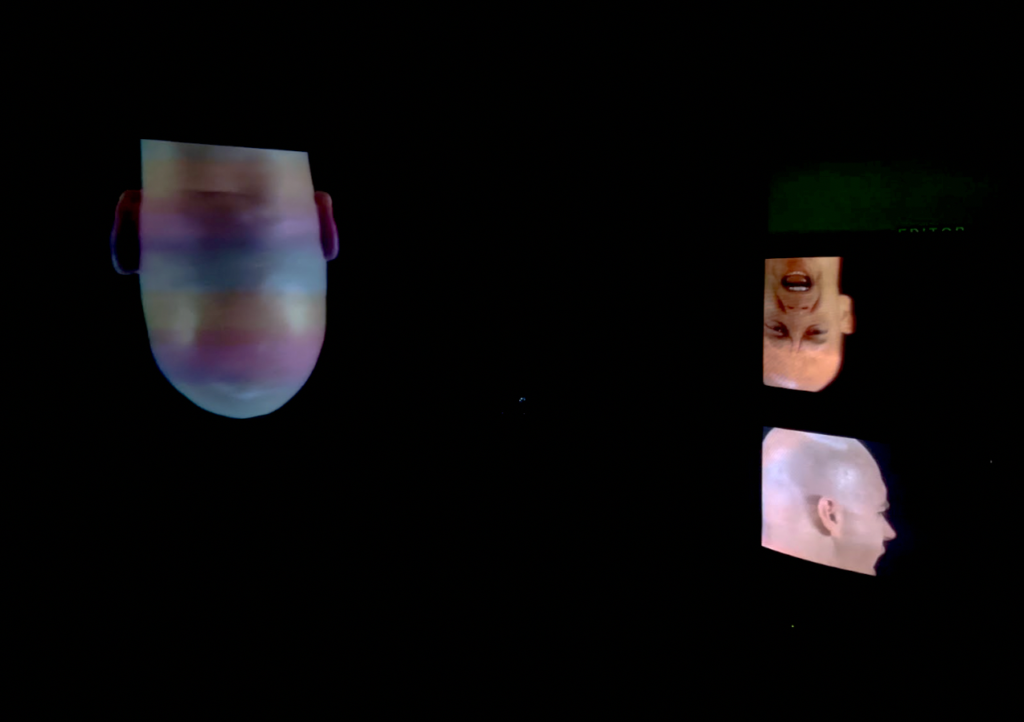
Anthro/Socio (Rinde-Spinning) 1992
This piece drew my attention even before I had entered the room. The sound of it is so intrusive and almost hypnotic because of its repetitive nature that it distracted me from experiencing the work exhibited in the previous room.
The combination of the sound and image however was even more overwhelming. There are projections on 3 sides of the rooms as well as a few old square TVs. So this overload of image and the surround sound and the overall repetition of all of these aspects becomes intrusive and almost threatening to the viewer.
The disembodied head repeatedly shouts “Feed Me, Eat Me, Anthropology”, “Help me, Hurt Me, Sociology” and “Feed Me, Help Me, Eat Me, Hurt Me” which are supposedly some of the most base human instincts. In my view the word anthropology is a representation of the disembodied head and its needs, whilst anthropology is the need for these needs to be met by other people.
Quite simply put this whole installation immediately made me think about infliction of panic and how aspects of this work could inspire the development of the state of panic I am exploring in my work.
Black Marble Under Yellow Light is a rather ambiguous work and the sculptural installation itself wasn’t of large interest to me however the fluorescent lights were very intriguing. The light created somewhat of an intimidating and unsettling atmosphere. Such lighting is often associated with sodium lights used for underpasses and railway goods yards. Underpasses are generally looked at as unsafe and threatening, because of the isolation they create for any individual passing through from the rest of the world and I suppose that the connotation to this specific yellow light being unsettling could have originated from there.
Nauman has used similar lighting in his earlier installation called Dream Passage with Four Corridors which incorporates 4 intertwining corridors with yellow and red neon lighting and in the intersection a table and chairs which mimic an interrogation room at a police station. The corridors are extremely narrow and the confinement combined with the almost aggressive lights contributes to an unpleasant and discomforting experience.
As evaluated from the exploration of these two works of Nauman’s I believe that incorporating this type of lighting in my work would take it one step further into communicating certain aspects of the state of Panic.
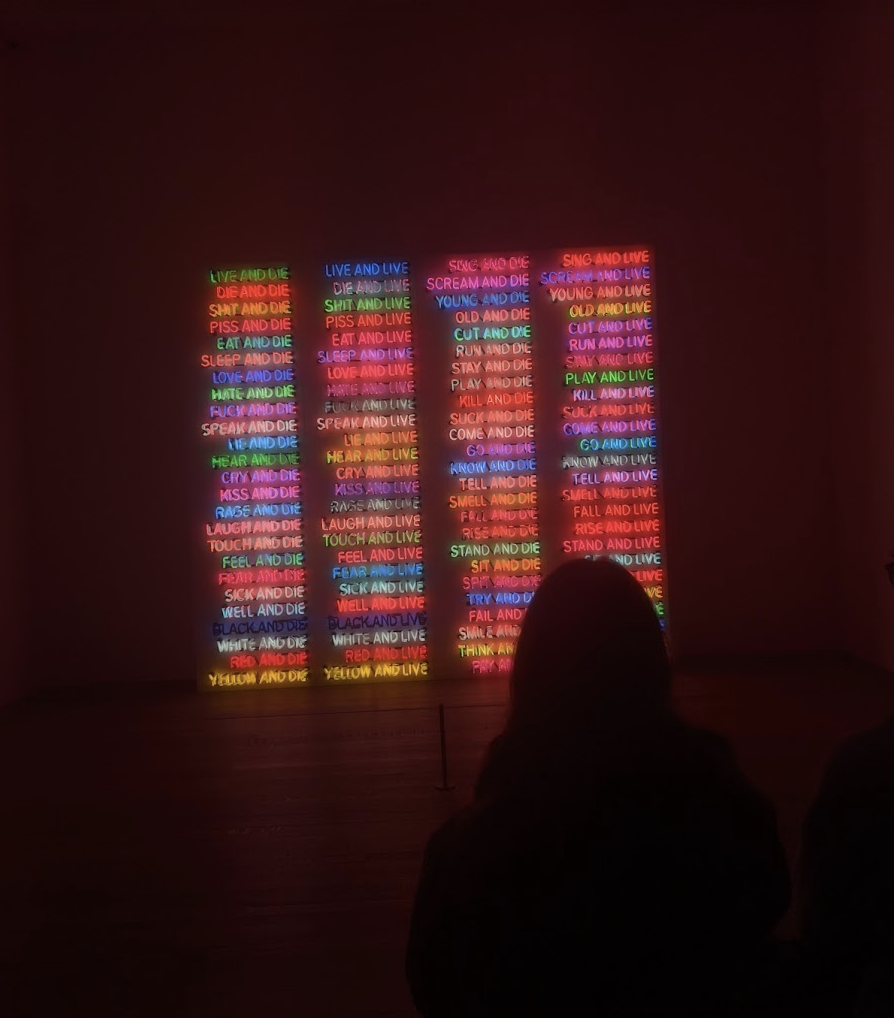
One Hundred Live and Die 1984
One Hundred Live and Die is made up of a large variety of contrasting declarations. The words are visible only when the light of a certain word is on because of the darkness in the room, which instantly creates a narrative as it doesn’t allow the viewer to randomly select the order of the words presented and so takes the story being told out of their hands.
The simplicity of the piece of it literary being contrasting words such of Live and Die combined with a variety of others such as Know & Live or Red & Die also creates ambiguity once again but also possibly openness to interpretation considering that the choice of selecting which words to read first has been taken away.
Overall an interesting experience and a powerful piece of work.
The development of my work continued with creating a shot list for the first shoot which can be downloaded below.
Searching for an actress/actor:
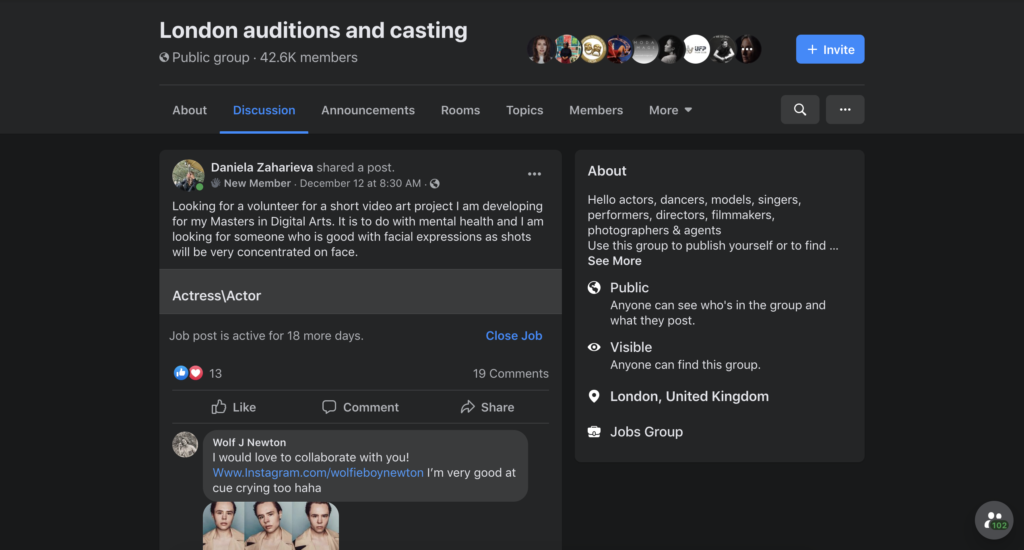
I started by posting an add on a Facebook Group called London Auditions and Casting.
2.I sent out emails to actor/esses I picked after going through their portfolios
3. Some couldn’t do the dates suggested, some got stuck in cities/countries with lockdown
4.I ended up collaborating with an actress and dancer called Stefania who was available and comfortable to shoot despite the pandemic and strict the strict rules. I followed procedure suggested by the government in regards to production during the pandemic and also got a consent form ready for Stefania to sign as seen below.
1st shoot.
The main focus of the shoot was to get a close up of facial expressions which simulate a development of anxiety which intensifies until it doesn’t.
As the project is shot at a very high frame rate, the lighting initially became an issue. There was a lot of flicker from the tunnel as half of it is essentially made up of solely lights.
In the trial shots I realised that I can use this flicker in my advantage and incorporate it into the core of the concept as a feature which leads the intensification of the anxiety that the character is experiencing.
It took a lot of trial and error in getting the right ISO level, aperture and shutter speed and eventually we got to an effect which worked well however more development will follow in the second day of shooting.
Below are the videos from the first shoot at the Light Tunnel:
Draft1.
This is a draft of the facial expressions. It is the shoot which worked best placed in the ellipse mask which is a shape that I have carried on from earlier experiments. This version doesn’t have any colour grading or editing however I have added it as documentation of the initial footage.
This video focused on a more narrative based story telling. The idea behind it was to bring more context to the expressional concept as in previous critical evaluations I had received feedback that I have to be aware of not being too vague.
I thought that having this sort of short-form narrative video presented on a flat screen along with the main piece being projected in a large scale could be a way forward. However there is still more aspects to take in consideration, more experiments to come which might lead me in a different direction.
In order to continue with the second shoot, I was hoping to receive a permission to use a tripod. I had already been waiting a while however I never managed to acquire the permission as anyone I contacted said it is not their ‘department’ or ‘property’ and I had to get on with filming. After going over all the footage and playing around with it in premiere, I have created and attached a pdf of a shot list for what needs to be reshot as seen below.
I went ahead and and did the second shoot without a tripod but did use a rig for stabilising some shots. I followed the shot list mentioned above, but also tried out some different angles and setting with the equipment, mainly in relation to embracing the flicker of the lights. As already mentioned, the initial issue of the flicker became an important part of the concept. It contributed to the sense of panic I am aiming to portray.
Thinking back to seeing Bruce Naumans exhibition – Bruce Nauman panic and this repetitive aspect of the spinning heads in Anthro/Socio (Rinde-Spinning) 1992, in a way the flicker became a similar technique of evoking panic or rather a sign of danger, something unrecognizable that the human body might need to quickly react to through a fight of flight instinct, which is essentially what anxiety is, your body protecting you from potential danger.
Development of Short Form Video
Continuing development of facial expressions focused video. It seems like there might not be enough time. to create both short-form video projects. However I will definitely develop it as planned, by continuing the development of the facial expressions focused video.
Development of Facial Expressions Video
After going through a variety of shots and gaining a large selection of versions of the facial expressions continuation I had to carefully go through all of them and pick which one worked best. That was rather difficult as the difference in between them was minimal yet it felt like the one I went for at the end had the most ambiguous, yet most expressive features to it.
It was very important for me to pick one specific video rather than stitching them together because of the continuation of the shot. The nature of the shot being slow motion also meant that any sort of abrupt transitions wold ruin the simulation like environment and break the connection between viewer and character which is a theme at the core of the concept.
After establishing the importance of certain shots and selecting the best executed ones in relation to communicating this concept of the almost invisible expression of anxiety and panic in the character I had to also think about one very important technical aspect of the video, stabilisation.
I started of by having a look at the tutorial here which led me through the steps of using after effects to stabilize a video. Stabilization was a very important aspect which yet again links back to the slow motion nature of the video. Stabilizing the video meant the expressions being communicated had a more fluid development.
SOUND
The sound planned in relation to the concept will be achieved through the previously mentioned techniques such as manipulation of pitch and length, echo, reverb and delay. I will be using the software audition and also Sound Grain which allows for a less controlled and more random manipulation of existing sounds which distorts the source to the point of the original being unrecognizable.
I have used my phone for the recording and have also introduced some previously recorded sounds from my sounds library. It could be argued that using a phone for the sound recording won’t allow for a good outcome due to potential poor quality, however as quality is not what I am aiming for but rather distortion, I do not find this to be an issue.
Drafts with Sound
Apart from the core of the sound which is the atmospheric sounds, I also added on some representational sounds such as the breathing, a heart beating and the high pitched noise which all contribute to the built up of the experience.
The high pitched sound especially is inevitably intrusive and almost painful to hear. Whilst the breathing and heart palpitations show us the invisible which is the physicality of struggling with mental health issues.
Fluorescent Yellow
As previously mentioned this type of fluorescent yellow light creates intimidation and is often used as a sign of caution or even danger. The colour itself is a way of warning people of areas or object with high hazards.
These connotations that this specific vibrant yellow colour holds contribute to communicating the sense of anxiety and panic in this piece. Simply put, anxiety is meant to function as a warning signal to any potential danger, however these warnings are often false as they are spiked from uncertainty and risk rather than something that would physically cause one harm.
Hence this intense and intrusive yellow glow aims to warn the viewer of the experience they are taking on by entering the space that it would be exhibited in. It is also conditioned as a way of mirroring the internal warnings that the character is experiencing in their state of panic and anxiety.
